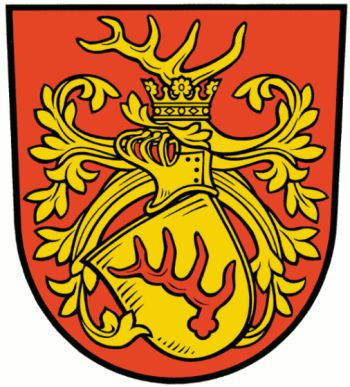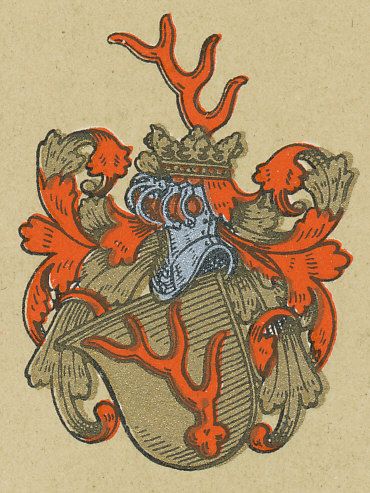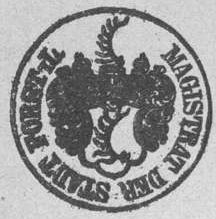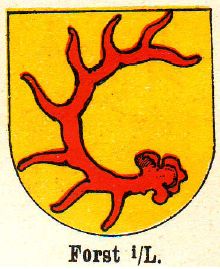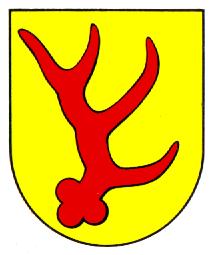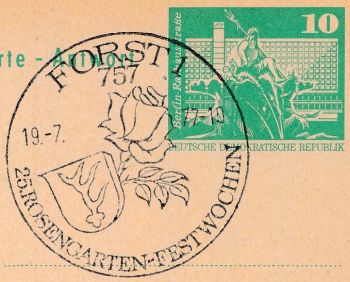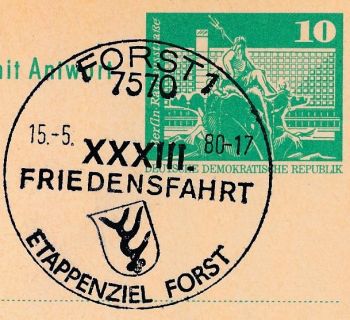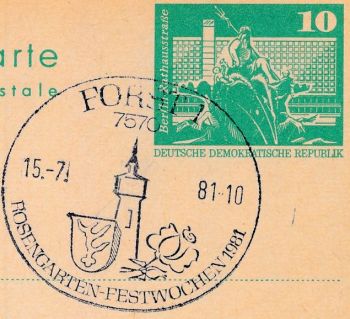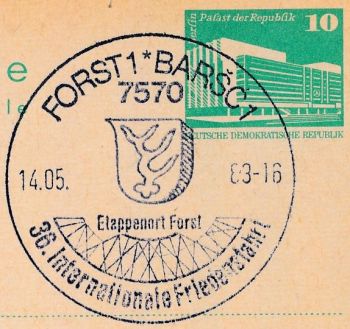Forst (Lausitz): Difference between revisions
Knorrepoes (talk | contribs) m (Text replacement - "===Official blazon=== *(de) " to "{| class="wikitable" |+Official blazon |- |'''German''' | ") |
Knorrepoes (talk | contribs) m (Text replacement - ". ===Origin/meaning===" to ". |- |'''English''' | {{blazon wanted}} |} ===Origin/meaning=== ") |
||
| Line 15: | Line 15: | ||
| | | | ||
In Rot ein goldener Schild, belegt mit einer linksgekehrten, fünfendigen roten Hirschstange. Auf dem Helm mit Decken aus einer Krone wachsend die Wappenfigur, alles golden. | In Rot ein goldener Schild, belegt mit einer linksgekehrten, fünfendigen roten Hirschstange. Auf dem Helm mit Decken aus einer Krone wachsend die Wappenfigur, alles golden. | ||
|- | |||
|'''English''' | |||
| {{blazon wanted}} | |||
|} | |||
===Origin/meaning=== | ===Origin/meaning=== | ||
The arms were officially granted on April 13, 2011. They were first granted on October 29, 1924 and confirmed on December 3, 2005. | The arms were officially granted on April 13, 2011. They were first granted on October 29, 1924 and confirmed on December 3, 2005. | ||
Revision as of 08:04, 5 July 2022
This page is part of the German heraldry portal Deutsche Wappensammlung |
Heraldry of the World |
|
German heraldry:
|
Selected collector's items from Germany:
|
FORST (LAUSITZ)
State : Brandenburg
District (Kreis) : Spree-Neisse
Additions : 1940 Domsdorf, Eulo, Keune, Noßdorf; 1946 Sarco; 1993 Bohrau, Briesnig, Groß Bademeusel, Groß Jamno, Horno, Klein Bademeusel, Klein Jamno, Mulknitz, Naundorf
| German |
In Rot ein goldener Schild, belegt mit einer linksgekehrten, fünfendigen roten Hirschstange. Auf dem Helm mit Decken aus einer Krone wachsend die Wappenfigur, alles golden. |
| English | (Lausitz) No blazon/translation known. Please click here to send your (heraldic !) blazon or translation |
Origin/meaning
The arms were officially granted on April 13, 2011. They were first granted on October 29, 1924 and confirmed on December 3, 2005.
The arms of Forst show a red antler in gold. The use of the antler is derived from the arms of the Lords of Bieberstein 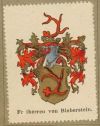 , who ruled the city from 1380-1667. When the city started to use the arms of the family is not known. The oldest known seal dates from 1595 and the arms granted in 1924 are based on that seal.
, who ruled the city from 1380-1667. When the city started to use the arms of the family is not known. The oldest known seal dates from 1595 and the arms granted in 1924 are based on that seal.
| The arms of Forst from 1924 (Rühl, 1928) |
During the centuries the antler has changed considerably in shape, position and the number of branches. In the late 19th century the arms used were mainly based on the composition of the seal of 1642, as shown in some examples below. As many different variations of the arms were used it was decided to use the composition of the oldest seal, which was discovered in 1909. The First World War delayed the procedure and the arms were finally granted in 1924.
During the DDR times the use of helmet, crest and mantling was discouraged and only the shield proper was used. In the 1990s the complete armorial bearings were restored, but for practical use only the shield itself is used.
In 2011 the whole historical composition was placed on a shield.
| The municipal stamp shown in 1892 |
The arms from around 1900 |
| Seal from around 1900 |
The arms by Hupp in the Kaffee Hag albums +/- 1925 |
| The arms from 1945-2011 | |
| Postal cancellation 1977 |
Postal cancellation 1980 |
| Postal cancellation 1981 |
Postal cancellation 1988 |
Contact and Support
Partners:
Your logo here ?
Contact us
© since 1995, Heraldry of the World, Ralf Hartemink 
Index of the site
Literature : Bensing et al., 1984; http://www.forst-lausitz.de


